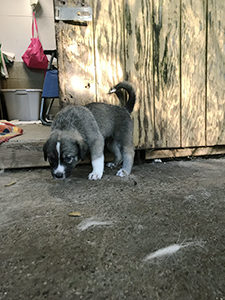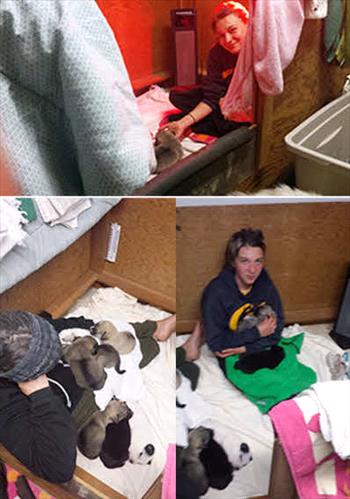In addition to my work at CattleDog Publishing, I am also involved (and have been most of my life) in rescuing and placing “Livestock Guardian Dog” breeds, in particular the rarer breeds. Livestock Guardian Dogs (LGDs) are dogs from specific breeds that have been used for thousands of years to protect livestock from predators such as bears and wolves. They live out with the flock or herd 24/7/365 and work without human guidance and little human intervention.
They were developed in what is known as Central Asia, likely close to where sheep and goats were domesticated, and from there spread west. There are over 40 different breeds of LGDs in use around the world, but most of them are little known outside of their regions of origin. Most people here in the USA have only heard of the Great Pyrenees (they are the “Big White Dogs” that some say look like white Saint Bernards) that are from the Pyrenees Mountains between France and Spain. LGDs are used to guard everything from sheep and goats, to artesian berries (from bears), organic vineyards (from deer), and even down under in Warrnambool, Australia, where they protect “Little Penguins,” the smallest of the penguin species, from Foxes. http://www.warrnamboolpenguins.com.au/maremma-dogs
The use of LGDs in the US started back in the 70’s (my family was one of the first to produce working Great Pyrenees), but has become a lot more common in the last 10 years and with it has brought an increase in people that don’t know really what they are doing, have gotten bad information or advice, and those who just need help. There has also been a corresponding increase is dogs needing rescue, but there are very few groups set up to deal with dogs that were not raised to be pets. LGD breed dogs often do not do well as ordinary pets, especially in urban or suburban settings and are not like the average dog in many ways.
I grew up raising, showing, and rescuing Great Pyrenees, then, about 10 years ago, I moved into the breeds that are less well known. Among those breeds are the Turkish LGD breeds Akbash and Anatolian Shepherd (this will be relevant shortly). I have always been interested in the history of the various working dog breeds as well as the proper training and handling of them. Part of what I do outside CattleDog Publishing involves mentoring people that are new to LGDs or that are having issues and trying to help them work out whatever it is they are having problems with, with the goal of keeping their dogs(s) happy, healthy, and out of rescue.
And this is where the puppies come in. A couple I was just starting to work on LGD issues with discovered much to their shock that their supposedly spayed female was not only pregnant, but ready to whelp within days! They were not only new to LGDs, but to dogs really, and not only knew nothing about whelping and raising pups, but were not prepared to do so in any way, shape, or form. Luckily, I was. So the mother came to stay with me and my lady, Carrie. We have space that can and was converted overnight to a whelping room and had the supplies needed on hand. Five days (and a two vet checks later) 9 healthy puppies were born. They are a mix of Great Pyrenees, Akbash and Anatolian and there are 6 boys and 3 girls.
The pups in our rescue program are now almost 4 weeks old and are being raised using techniques and information laid out by Dr. Sophia Yin in her book Perfect Puppy in 7 Days, with some modifications for dogs that may end up being working farm dogs. We started handling them from birth and through the neonatal and transition periods laid out in Chapter 1. Through this time, they were also read to or sung to so as to get them used to first the vibrations of sounds, then the sounds of our voices. This helps them prepare for other sounds they will hear as they move into the “Sensitive Period for Socialization,” a very critical time in their early development. We also continued to handle them in various positions and petted and gave ear rubs (an area of pleasure in dogs).
This week they are being exposed to areas outside of their whelping box, along with mom, and are experiencing new sights, smells, and floor textures (they had been on a raised floor covered in blankets and potty pads). They are also now hearing other dogs more clearly (we have several rescue fosters in an adjoining area) as well as noises of the world. This exposure is done slowly and under supervision with mom near by so as not trigger fear responses, which can continue on into adulthood and lead to many problems, such as lack of confidence, fear of men, or even “fear biting.” Now that they can hear, we are also introducing certain words so that they tie them to actions or things, such as, of course, their litter box names, going to the bathroom (we tell them “good potty” when they go on their own, that ties the words to the action which is important later on if taking walks or long road trips!), and “sit” when they sit on their own while going about their day.
This week they are being introduced to solid food, starting with what we call “puppy pablum,” which is puppy kibble that is mixed with puppy milk replacer and blended into a mush. This is in addition to the milk they still get from mom. Mom is already wanting to wean them, and she will do so over the next 3 weeks or so until they are on nothing but puppy food. We will also be handling them more and exposing them more to the outside world. Due to health concerns, though, they will have limited exposure to other people, dogs, and farm animals until after they have begun their vaccination schedule. Once that happens, they and mom will be moved down to a kennel that is inside a “goat yard” for testing to see who will make a good working dog, and who just wants to hang with humans (their personalities and actions determine this). This also exposes them to another new environment and with it new sights, sounds, smells, and creatures, which is part of the ongoing socialization during the “Sensitive Period”.
I will be posting more pictures, some videos, and keeping you updated on their progress and how the Perfect Puppy in 7 Days book is used to help them get ready for their new life.
If you would like more information on LGDs, please visit LGD.org.
For Further Reading:
- Perfect Puppy in 7 Days: How to Start Your Puppy Off Right
- Creating the Perfect Puppy: How to Start off Right and Stay on Track







